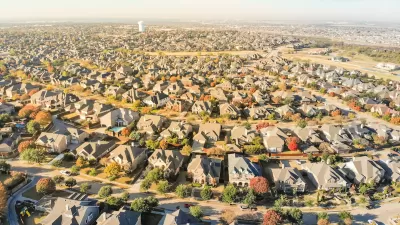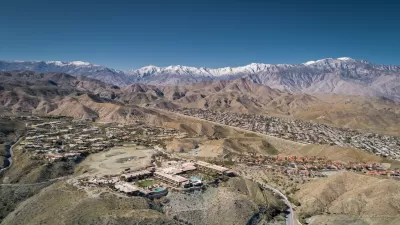A new article by city historian Graeme Davison traces the rise and fall of the suburban paradigm from its ideological roots in Victorian England to its current backlash.
Eric Jaffe provides a synopsis of Davison's "brief though rather complete" history of the rise and fall of the suburban lifestyle that appeared in a recent issue of the Journal of Urban History. "Concentrating on England, but drawing support from the United States and Australia, Davison tracks suburbia from its ideological roots in the Victorian era to its harsh detractors in the present."
He begins his history with the outward expansion of England's industrial cities in the 19th century. "Davison argues that it wasn't just 'sheer pressure of population' that encouraged this early form of sprawl. Many factors played a role in the change, including improved rail transit that facilitated movement inside and outside town centers. Davison also points to four major ideologies—one each in the realms of religion, science, the arts, and social life—as critical sources of the shift." These include Evangelicalism, Sanitarianism, Romanticism, and Class Segregation.
"With the rise of suburbia came the rise of its enemies," says Jaffe. "Libertarians rejected Evangelical morality. Socialists rejected class segregation. Artistic realism led to a rejection of Romanticism. Improvements in medicine assuaged many health fears. Suburbia became an emblem of social snobbery in the hands of Thackery and Dickens: a place full of wealth but devoid of taste."
"The suburb was simply too spacious, too clean, too safe, too conventionally virtuous, too sanctimonious," writes Davison.
FULL STORY: A Brief History of Suburbia's Rise and Fall

Study: Maui’s Plan to Convert Vacation Rentals to Long-Term Housing Could Cause Nearly $1 Billion Economic Loss
The plan would reduce visitor accommodation by 25,% resulting in 1,900 jobs lost.

North Texas Transit Leaders Tout Benefits of TOD for Growing Region
At a summit focused on transit-oriented development, policymakers discussed how North Texas’ expanded light rail system can serve as a tool for economic growth.

Using Old Oil and Gas Wells for Green Energy Storage
Penn State researchers have found that repurposing abandoned oil and gas wells for geothermal-assisted compressed-air energy storage can boost efficiency, reduce environmental risks, and support clean energy and job transitions.

Santa Barbara Could Build Housing on County Land
County supervisors moved forward a proposal to build workforce housing on two county-owned parcels.

San Mateo Formally Opposes Freeway Project
The city council will send a letter to Caltrans urging the agency to reconsider a plan to expand the 101 through the city of San Mateo.

A Bronx Community Fights to Have its Voice Heard
After organizing and giving input for decades, the community around the Kingsbridge Armory might actually see it redeveloped — and they want to continue to have a say in how it goes.
Urban Design for Planners 1: Software Tools
This six-course series explores essential urban design concepts using open source software and equips planners with the tools they need to participate fully in the urban design process.
Planning for Universal Design
Learn the tools for implementing Universal Design in planning regulations.
Ascent Environmental
Borough of Carlisle
Caltrans
Institute for Housing and Urban Development Studies (IHS)
City of Grandview
Harvard GSD Executive Education
Toledo-Lucas County Plan Commissions
Salt Lake City
NYU Wagner Graduate School of Public Service





























